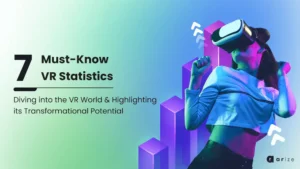The success of a brand often relies on the emotional connection that consumers form with it through tangible experiences. This includes walking around a store and having other sensory experiences in a brick-and-mortar environment. However, with the rise of e-commerce, delivering a physical experience to customers is innately more challenging. Retailers must look beyond standard practices to immerse consumers in brand experiences. This is where augmented reality (AR) comes in.
What is AR?
Augmented Reality (AR) is a technology that superimposes computer-generated images of a user’s environment to provide them with an improved version of reality. Integrating different digital information forms (sounds, images, text, etc.) into the user’s real-time environment.
The idea is to combine the virtual and the real, giving the user the illusion of perfect integration.
AR in E-Commerce
The use of AR in e-commerce aims to give consumers an immersive experience. It allows them to experience real-time product interaction while remaining in their environment.
When used correctly, AR bridges the gap between a customer’s experience in a physical store and the colder, less immersive online shopping experience.
As a result of the COVID-19 pandemic restricting how and when retail shops could operate, the gap between these experiences was even more widely felt, leading to a surge in the use of AR in the industry to try and bring online shopping more in line with its traditional counterpart.
The Benefits of Augmented Reality
There are multiple ways that AR is transforming online shopping, bringing plenty of benefits to retailers that choose to employ it. Let’s look at some of them.
Personalized Online Shopping
AR can personalize a customer’s online shopping experience to a greater degree. They can find tools that let them see what clothes look like on them, what styles would suit them, or what a product would look like placed in their physical space. This is a better alternative than looking at models, mannequins wearing clothes, or showrooms displaying furniture.
This level of customization will improve the experience.
Improves Conversion Rates
An improved, more personal experience will lead to better conversion rates, one of AR’s most distinctive benefits. Shoppers are more likely to complete the purchase process if they are more informed about the product they will buy and have a better idea of how it will look, feel, and perform. A more engaging product experience results in improved conversion rates.
On the flip side, it can also lead to reduced return rates. Research has found that many customers (30%) have returned items they bought online for various reasons, including goods not being as they were described or matching how they looked on screen. AR can save retailers money on refunding, exchanging, and organizing returns.
Improving Customer Relationships
The immersive experience brands create allows them to engage with consumers in a whole new way and build long-lasting and meaningful relationships. AR helps increase consumer and brand engagement, ultimately leading to more business.
Research has shown that retailers who have utilized AR technology are seeing a 19% increase in customer engagement. Furthermore, conversion rates increase by 90% for consumers who engage with AR versus those who do not.
It will continue to grow.
With the advent of digital technology, e-commerce makes shopping and selling more satisfying and convenient for the average person. The introduction of AR is making it even more compelling.
Major retailers and their customers now prefer an AR-based e-commerce experience to an experience without augmented reality.
This is also due in part to the changing tastes of younger generations. It is reported that 30% of millennial and Gen Z consumers seek more interactive shopping experiences, incorporating AR and VR technology.
Augmented reality in online shopping offers consumers a new and more intimate experience, allowing shoppers to interact in real-time with products while remaining in the comfort of their environment. Moreover, AR enables businesses to inform and connect with customers and continue to engage consumers after they’ve made a purchase.
AR is pushing the envelope in many different areas, quickly becoming an indispensable tool in modern business.



